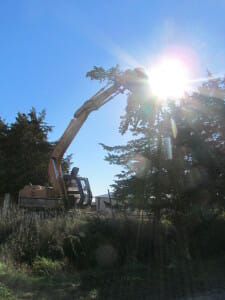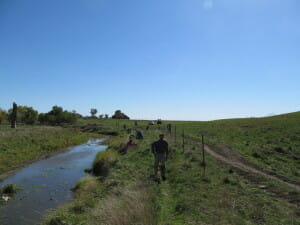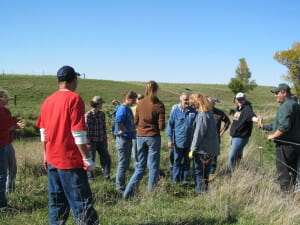Riparian Buffers & Groves: From Planning to Care
Cashing in on some good weather, a motivated and interested crew met up at the Griffieon Family Farm in Ankeny on Oct 12. The agenda for the day was learning about tree planting and management for windbreaks and riparian buffers, and then applying that knowledge with some hands-on planting.
After some brief intros led by Jeff Jensen of Trees Forever, the group went down the road to see how old trees could be removed. The Griffieon’s son-in-law, Laramie Ogden, is fortunate to work for J Pettiecord and was able to bring a trackhoe excavator (with a hydraulic thumb) to demonstrate quick tree removal. Small cedars were simply ripped out of the ground; larger ones first had the tops torn off, and then the trunks pulled over, pulled out of the ground, and then dumped. The wood will mostly be used for fuel. It took less than 20 minutes to tear out four trees. That land will be rested for a year or two before replanting.
The group then moved up the road for some grove installation, to contrast the breakdown. Laramie’s wife, the Griffieon’s daughter Autumn, was prepared to plant a windbreak. LaVon showed maps that she had received from NRCS, showing the farm, houses, buildings, and soils. Planning is more than just deciding to get a bunch of trees and putting them where you want a windbreak! Spacing between the trees is important, as is species selection. LaVon passed around a soil map of the farm areas where windbreaks were going in – it turns out that the reason one tree on the property corner had never really taken off, was that the soil type changed! She said that once the soils were identified, species selection was possible. Here the farmer must choose what they hope to get out of the buffer. At Autumn’s place, the species provided visual attractiveness (lilacs and arrowwood), food for harvest (hazelnuts and highbush cranberry), and sturdy shelter (conifers). In addition to the functional diversity, having a variety of tree types ensures that a sudden influx of disease or pests is unlikely to wipe out the entire stand. LaVon also spoke to the difficulty of finding trees. They are only dug up when dormant – so not until after a frost. Finding trees this fall was difficult, to say the least. Tree auction prices can go through the roof, and there are no guarantees on quality or longevity.
Jeff demonstrated proper tree planting methods, which is more technical than it might seem. He said that one common problem is planting the trees too deep – he showed how to lay a shovel handle across the hole, as a “level.” The point where the tree’s trunk converts to roots – characterized by a change in bark color and a sudden widening of the bole – is where the soil line should be. He also stressed the importance of releasing the root ball once it’s out of the pot. Many times, roots start winding around the inside of the pot; if left like this in the soil, they can grow too large and choke off the tree. Along with roughing up the inside of the hole, if it had been planed smooth by the auger, opening the roots promotes better soil penetration and tree health. With that, the group went to work, and within 90 minutes, over a hundred trees were planted and watered. The trees were to be planted in three rows on the north and west sides of the property, against the prevailing winds; species were grouped together.
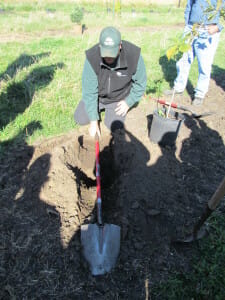
Trees Forever representative Jeff Jensen shows how to lay the shovel across the hole for the tree. The dirt fill line will be at the bottom of the shovel – make sure the tree is planted to the right depth!
During lunch (many thanks to LaVon for the delicious food, and for the rest of the family’s support and hospitality!), Polk County NRCS representative Paul Miller talked about some of the cost-share possibilities. Windbreaks and riparian groves are one of the only practices that can be cost-shared without any income being derived from the land (i.e. it does not need to be cropland or otherwise in production). Through REAP, NRCS can cost-share 75% of the grove installation, up to $1500. Jeff also added that Trees Forever can piggyback on NRCS and provide additional funds, for instance allowing the landowner to purchase larger trees than afforded by the NRCS funds. Jeff also talked about aronia berries and the growing interest in those high-antioxidant fruits. While not always peoples’ first choice by taste, they add health benefits to baked goods or juices, and represent a potential high-value crop for landowners. While he cautioned that aronias (or other food-bearing trees or bushes) will not yield to their maximum potential when planted as part of a windbreak, they’re an added bonus to an environmental project.
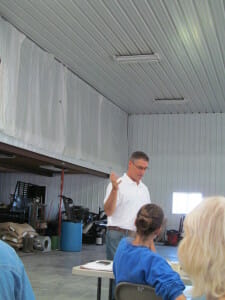
NRCS specialist Paul Miller discusses cost-share opportunities for those wanting to add trees to their land.
Fueled up by good eats, the group did some more planting. This time it was a riparian buffer along the edges of a creek running through the Griffieon’s pasture paddocks. While the animals don’t have access to the creek, time and precipitation tend to wear down land near waterways. Then Griffieons had the banks reformed and seeded about four years ago to avoid erosion and soil loss, and planting trees enhance the conservation efforts. Species selected must be tolerant of occasional flooding: swamp white oaks, bur oaks, sycamores, and black walnuts were alternated up and down both sides of the stream. Jeff discussed some other considerations; many farms have riparian areas in CRP contracts. A landowner wanting to add some trees to that area cannot make profit off of it, at least not during the contract itself. However, trees may be able to be planted if the landowner asks to modify the contract to allow planting for diversity. Then, with the holes dug and trees in tow, many hands made light work and the day’s total tree planting was brought to 310.
Back at the home farm for a bit of conversation, some folks went to check out the Griffieons’ chicken and turkey tractors. Others sat and talked about their own potential groves, and many spoke with Jeff about his hazelnut work. He is part of breeding projects to develop consistent bushes that provide thin-skinned, high-percentage kernel nuts. At the moment, there are no true varieties of hazelnuts; individual growers may have entirely different genetic stocks. So through recordkeeping and nut quality and yield testing, he and others are working to improve the attractiveness of hazelnuts for the future.
This summer, Practical Farmers has worked to provide some hands-on field days, with the idea that on-farm learning and sharing can only be enhanced when people get their hands dirty. Feedback and ideas are always appreciated!

